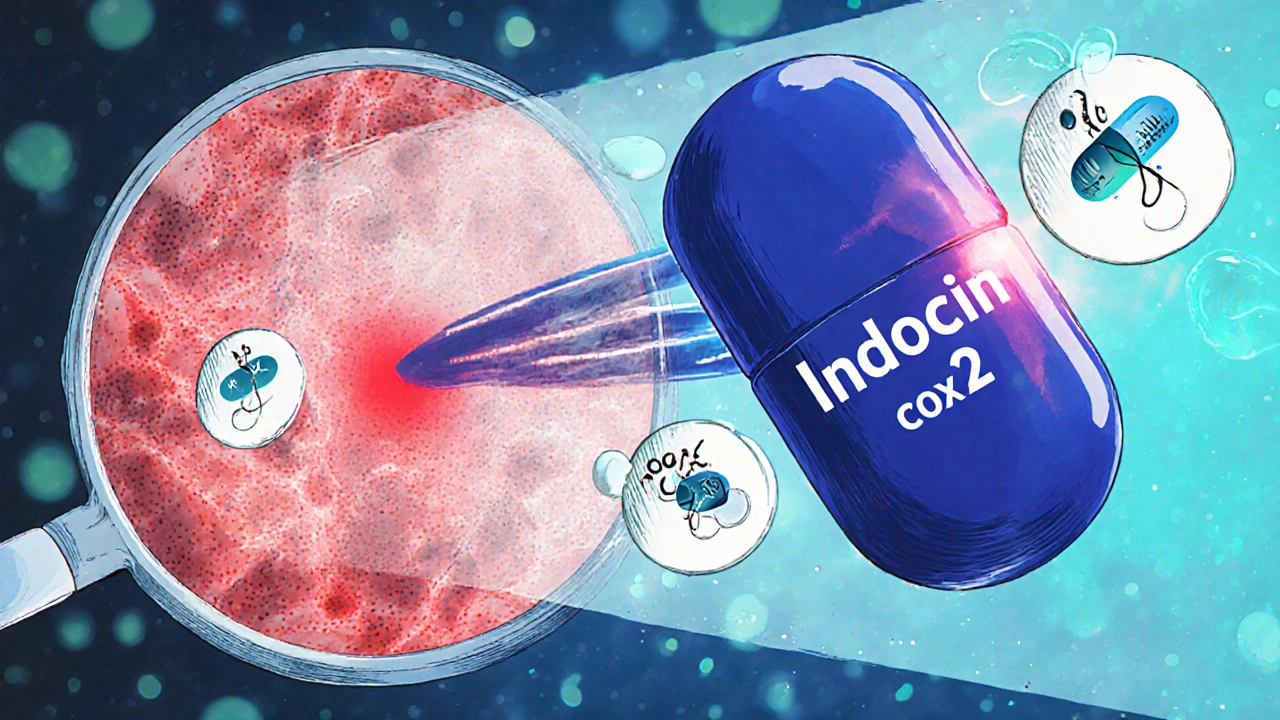NSAID Selection Tool
Find your best NSAID option
Answer a few questions to get personalized recommendations based on your specific needs and health profile.
Your Pain Situation
Your Health Profile
Choosing the right pain‑relief medication can feel like navigating a maze of brand names, dosages, and side‑effect warnings. If you’ve been prescribed Indocin (Indomethacin) for arthritis or severe inflammation, you probably wonder how it stacks up against the over‑the‑counter options you see on pharmacy shelves. This guide helps you weigh alternative NSAIDs against Indocin, breaking down how they work, how effective they are, and what safety signals you should watch for.
What makes Indocin different?
Indocin belongs to the non‑steroidal anti‑inflammatory drug (NSAID) family, but its chemistry gives it a potency that many over‑the‑counter pills lack. The drug blocks both COX‑1 and COX‑2 enzymes, the same targets that drive pain and swelling. In micro‑terms, Cyclooxygenase (COX) converts arachidonic acid into prostaglandins, which signal the brain that something is inflamed. By inhibiting COX, Indocin cuts the prostaglandin cascade and delivers fast, lasting relief.
Because Indocin hits both COX isoforms strongly, it’s especially useful for conditions that need aggressive inflammation control, such as rheumatoid arthritis, gout flares, and ankylosing spondylitis. However, that same broad inhibition also raises the risk of gastrointestinal (GI) irritation and kidney strain, which is why doctors often keep it as a second‑line therapy.
Common alternatives on the market
Most patients encounter these NSAIDs first when they try to manage mild to moderate pain without a prescription:
- Ibuprofen - A workhorse NSAID sold under brand names like Advil and Motrin. It leans slightly toward COX‑2 inhibition, offering a balance of pain control and fewer stomach complaints at standard doses.
- Naproxen - Known for its long half‑life, Naproxen (Aleve) stays in the system for up to 12hours, making it a popular choice for chronic conditions that need steady coverage.
- Celecoxib - A prescription‑only COX‑2‑selective inhibitor marketed as Celebrex. It was designed to spare the stomach, though it carries a modest increase in cardiovascular risk.
- Aspirin - The original NSAID, still used for low‑dose heart protection and occasional pain relief. Its antiplatelet effects set it apart from the other drugs on this list.
- Diclofenac - Available orally and as a topical gel, Diclofenac (Voltaren) targets joint pain with a relatively high COX‑2 preference.
- Meloxicam - Another prescription NSAID that sits between non‑selective and COX‑2‑selective agents, often prescribed for osteoarthritis.
Each of these alternatives brings a slightly different mix of potency, dosing convenience, and side‑effect profile. Understanding those nuances helps you decide whether a drug like Indocin is necessary or whether a milder NSAID will do.
Efficacy at a glance: How do they compare?
| Drug | Typical Dose | Onset of Pain Relief | Duration of Action | GI Risk (↑ = higher) | Cardio Risk (↑ = higher) |
|---|---|---|---|---|---|
| Indocin | 25-50mg 2-3×/day | 30‑60min | 4‑6h | ▲▲▲ | ▲ |
| Ibuprofen | 200‑400mg q6‑8h | 15‑30min | 4‑6h | ▲▲ | ▲ |
| Naproxen | 220‑500mg BID | 30‑45min | 12‑15h | ▲ | ▲ |
| Celecoxib | 100‑200mg q12h | 45‑60min | 8‑12h | ▲ | ▲▲ |
| Aspirin | 325‑650mg q4‑6h | 15‑30min | 4‑6h | ▲▲▲ | ▲ |
| Diclofenac | 50‑150mg q8h | 30‑45min | 6‑8h | ▲▲ | ▲▲ |
The table shows why Indocin shines for fast, strong pain control but also why its GI risk sits at the top of the scale. If you can tolerate the stomach upset, Indocin may let you skip higher doses of weaker NSAIDs.

Safety considerations you can’t ignore
All NSAIDs share a core set of warnings, but the intensity varies:
- Gastrointestinal ulceration: Blocking COX‑1 reduces protective prostaglandins in the stomach lining. Indocin’s non‑selective action makes it a leading cause of NSAID‑related Gastrointestinal ulcer. Using a proton‑pump inhibitor (PPI) alongside the drug can blunt the damage.
- Kidney function: Reduced prostaglandin flow can lower renal blood flow, especially in older adults or those taking diuretics. Monitoring serum creatinine after starting any NSAID is prudent, but the risk rises sharply with Indocin.
- Cardiovascular events: COX‑2‑selective drugs like Celecoxib have a clearer link to heart attacks. Indocin’s mixed profile puts it somewhere in the middle-still a caution for patients with existing heart disease.
- Bleeding tendency: Aspirin’s antiplatelet effect makes it a double‑edged sword-great for preventing clots but risky for anyone prone to bruising.
When you weigh the pros and cons, ask yourself:
- Do you have a history of ulcers or gastritis?
- Is kidney function already compromised?
- Are you on blood thinners or antihypertensives?
- What level of pain relief do you truly need?
Answers to these questions steer you toward the most suitable NSAID.
Choosing the right NSAID for your situation
Here’s a quick decision matrix you can run in your head or on a piece of paper:
- If you need rapid, potent relief for a severe flare of rheumatoid arthritis and your doctor monitors your stomach, Indocin is a solid pick.
- If you prefer a daily, low‑maintenance option for mild osteoarthritis, Naproxen or Meloxicam may suffice.
- When cardiovascular safety tops the list, a COX‑2‑selective drug like Celecoxib paired with a low‑dose aspirin for heart protection can work-just watch the blood‑pressure numbers.
- For occasional headaches or minor muscle aches, the over‑the‑counter duo of Ibuprofen or Aspirin is usually enough.
Never mix multiple NSAIDs without medical guidance; the combined COX inhibition can tip the safety balance dramatically.
Quick checklist before you start
- Confirm diagnosis (e.g., rheumatoid arthritis, gout, osteoarthritis).
- Screen for ulcer history or current GI symptoms.
- Check baseline kidney labs (creatinine, eGFR).
- Review heart disease, hypertension, or stroke risk.
- Discuss any concurrent meds-especially blood thinners, ACE inhibitors, or diuretics.
- Decide on gastro‑protective strategy (PPI, H2 blocker, or misoprostol).
- Set a follow‑up date to reassess pain control and side‑effects.
Following this list helps you avoid surprises and keeps the focus on pain relief, not complications.
Frequently Asked Questions
How quickly does Indocin start working?
Most patients notice a reduction in pain and swelling within 30 to 60 minutes after taking the first dose.
Can I take Indocin with ibuprofen?
Mixing two non‑selective NSAIDs raises the risk of stomach bleeding and kidney stress. It’s best to avoid the combination unless a doctor explicitly advises it.
Is a proton‑pump inhibitor necessary with Indocin?
For anyone with a prior ulcer, regular PPI use (e.g., omeprazole 20mg daily) substantially cuts the chance of GI complications while on Indocin.
What are the main differences between Indocin and celecoxib?
Indocin blocks both COX‑1 and COX‑2, offering stronger pain relief but a higher ulcer risk. Celecoxib selectively inhibits COX‑2, sparing the stomach lining but carrying a slightly higher cardiovascular warning.
Can I use Indocin long‑term?
Long‑term therapy is possible, but doctors usually add a protective PPI and schedule regular blood‑work to watch for kidney or liver changes.






Alexis Howard
October 17, 2025 AT 14:54Indocin gets all the hype but ibuprofen does the job just fine.
Darryl Gates
October 30, 2025 AT 08:21If you’re starting Indocin, pair it with a proton‑pump inhibitor and monitor your stomach health; that small precaution can keep you on the medication without the dreaded ulcer risk.
Kevin Adams
November 12, 2025 AT 02:47Behold, the thunderous clash of chemical titans! Indocin storms in like a tempest, laying waste to inflammation in minutes, while the humble ibuprofen tiptoes quietly in the background, unnoticed. Yet, the price of such fury is a wounded gut, a silent scream of the stomach lining. Do we not, as mortal seekers of relief, accept the bargain? The choice is yours, brave reader, and the consequences shall echo through your veins.
Katie Henry
November 24, 2025 AT 21:14Esteemed colleague, allow me to extol the virtues of diligent monitoring: regular renal panels, vigilant assessment of cardiovascular status, and the judicious use of gastro‑protective agents together compose a symphony of safety whilst harnessing Indocin’s potent anti‑inflammatory power.
Nickolas Mark Ewald
December 7, 2025 AT 15:41Sounds good – stick with the basic NSAID if the pain isn’t extreme and add a PPI if you have any stomach issues.
Chris Beck
December 20, 2025 AT 10:07Honestly the US makes the best meds, none of that weak European stuff – Indocin is a real American powerhouse and you should trust it over any foreign OTC.